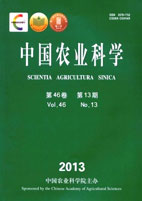-
Effects of Two Chinese Medicinal Ingredients on Lipid Metabolism in Broilers
- ZHANG Xiang-Jie, SUN Yao-Gui, CHENG Jia, LI Hong-Quan, WANG Jun-Dong
-
Scientia Agricultura Sinica. 2013, 46(13):
2788-2795.
doi:10.3864/j.issn.0578-1752.2013.13.016
-
 Abstract
(
751 )
Abstract
(
751 )
 PDF (574KB)
(
999
)
PDF (574KB)
(
999
)
 Save
Save
-
References |
Related Articles |
Metrics
【Objective】The experiment was conducted to investigate the effects of TFHL, TSG and TFHL+TSG supplement in daily ration for broilers on slaughter performance, serum biochemical index and expressions of lipid metabolism related genes.【Method】One hundred and twenty-eight male broilers (1 day old) were divided randomly into 4 groups:control group (fed a basal corn-soybean meal diet), groupⅠ (basal diet+300 mg•kg-1 TFHL), groupⅡ (basal diet+150 mg•kg-1 TSG) and group Ⅲ(basal diet+300 mg•kg-1 TFHL+150 mg•kg-1 TSG). Four replicates were designed for each group and each replicate had 8 broilers.【Result】Compared with the control group, the eviscerate percentage, serum HDL-C, mRNA expressions of PPARα, CPT-Ⅰ in liver tissue in groupⅠwere significantly higher (P<0.05); the abdominal fat percentage, serum TG, TC and LDL-C, mRNA expressions of SREBP-1, ACC and FAS in liver tissue were significantly decreased (P<0.05). Compared with the control group, the dressing percentage, serum HDL-C and FFA, mRNA expressions of PPARα, CPT-Ⅰ in liver tissue in groupⅡwere significantly higher (P<0.05). The abdominal fat percentage, serum TG, TC and LDL-C, mRNA expressions of SREBP-1, ACC and FAS in liver tissue were significantly decreased (P<0.05). Compared with the control group, the dressing percentage, semi-eviscerate percentage, eviscerate percentage, breast muscle percentage, leg muscle percentage and subcutaneous fat thickness in group Ⅲ were significantly higher (P<0.05). The dressing percentage and eviscerate percentage in group Ⅲ were much higher than those in groupsⅠand Ⅱ (P<0.05), and the leg muscle percentage was much higher than groupⅠ (P<0.05). The abdominal fat percentage in group Ⅲ was significantly lower than that of control group, groupsⅠand Ⅱ(P<0.05). The TG, TC and LDL-C of serum in group Ⅲ were significantly lower than those of the control group, groupsⅠand Ⅱ(P<0.05).Compared with the control group, the HDL-C, FFA, TP and ALB of serum in group Ⅲ were significantly higher (P<0.05). The HDL-C and FFA of serum in group Ⅲ were significantly higher than those in groupsⅠand Ⅱ(P<0.05). Compared with the other groups, mRNA expressions of PPARα, CPT-Ⅰ, LPL in group III were significantly higher (P<0.05), and the expressions of SREBP-1, ACC and FAS in liver in group III were significantly decreased (P<0.05).【Conclusion】Supplemental dietary TFHL and TSG could increase the mRNA expressions of PPARα, CPT-Ⅰand LPL, reduce the mRNA expressions of SREBP-1, ACC and FAS, improve the lipid metabolism related biochemical index in serum, raise slaughter performance. Taking all factors into consideration, it is better to add the two ingredients to diet at the same time.









